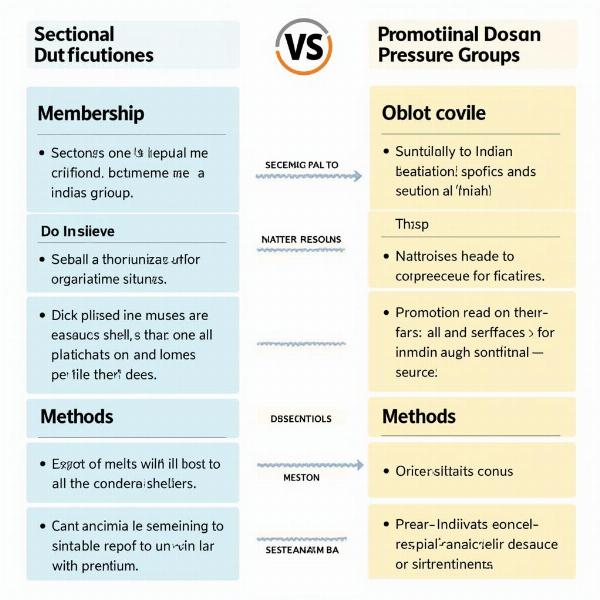Understanding the concept of pressure groups is crucial in the context of Indian democracy. “Pressure groups meaning in Hindi” translates to “दबाव समूहों का अर्थ हिंदी में”. This article will delve into the meaning, types, functions, and impact of pressure groups within the Indian political landscape. We will explore how these groups influence policy decisions and represent various interests within society.
What are Pressure Groups? (दबाव समूह क्या हैं?)
Pressure groups, also known as interest groups or advocacy groups, are organizations that aim to influence government policies and decisions without directly seeking political power. They represent specific interests, causes, or sections of society and work to promote those interests by lobbying, protesting, raising public awareness, and engaging in other forms of advocacy. In India, these groups play a significant role in shaping public discourse and policy outcomes.
Types of Pressure Groups in India (भारत में दबाव समूहों के प्रकार)
Pressure groups in India can be categorized into various types based on their structure, objectives, and methods:
- Sectional Groups: These represent specific sections of society, such as trade unions (e.g., Bharatiya Mazdoor Sangh), business associations (e.g., Confederation of Indian Industry), or professional bodies (e.g., Indian Medical Association). They focus on protecting the interests of their members.
- Promotional Groups: These advocate for specific causes or issues, such as environmental protection (e.g., Greenpeace India), human rights (e.g., Amnesty International India), or animal welfare (e.g., People for the Ethical Treatment of Animals).
- Anomic Groups: These are spontaneous and short-lived groups that emerge in response to specific events or issues. They often involve protests and demonstrations.
 Sectional vs. Promotional Pressure Groups
Sectional vs. Promotional Pressure Groups
Functions and Impact of Pressure Groups (दबाव समूहों के कार्य और प्रभाव)
Pressure groups perform several important functions in a democracy:
- Interest Articulation: They voice the concerns and demands of various sections of society, ensuring that these are heard by policymakers.
- Policy Influence: They lobby government officials, engage in public campaigns, and use various other methods to influence policy decisions.
- Public Awareness: They educate the public about important issues and mobilize public opinion to support their cause.
- Accountability: They hold the government accountable for its actions and policies.
In India, pressure groups have significantly impacted various policy areas, including environmental protection, labor laws, and economic reforms.
Challenges Faced by Pressure Groups in India (भारत में दबाव समूहों के सामने चुनौतियाँ)
Despite their importance, pressure groups in India face several challenges:
- Lack of Resources: Many groups, especially those representing marginalized communities, struggle with limited funding and resources.
- Lack of Transparency: Some groups lack transparency in their operations and funding, raising concerns about accountability.
- Unequal Influence: Some powerful groups, particularly business lobbies, exert disproportionate influence on policy decisions.
Conclusion (निष्कर्ष)
Pressure groups (“दबाव समूह” in Hindi) are essential components of a vibrant democracy. They provide a platform for citizens to participate in the political process and ensure that their voices are heard. While they face various challenges, pressure groups continue to play a vital role in shaping India’s political landscape and influencing policy decisions.
FAQ
- What is the main purpose of a pressure group? Pressure groups aim to influence government policies and decisions to advance their specific interests or causes.
- How do pressure groups influence policy? They use various methods, including lobbying, public campaigns, protests, and media engagement.
- Are pressure groups good for democracy? While they can be beneficial by representing diverse interests, concerns about transparency and unequal influence need to be addressed.
- What are some examples of powerful pressure groups in India? Examples include the Confederation of Indian Industry (CII) and the Bharatiya Kisan Union (BKU).
- How can I join a pressure group? Most pressure groups have websites and contact information where you can learn about their work and how to get involved.
- What is the difference between a pressure group and a political party? Pressure groups do not aim to directly control political power, while political parties contest elections and form governments.
- What are the negative impacts of pressure groups? Some pressure groups can be overly focused on their own narrow interests, potentially harming the broader public good.
Meaning-Hindi.in is a leading provider of high-quality Hindi translation services, specializing in various domains, including business, legal, technical, website localization, and academic translations. We offer accurate, culturally sensitive translations to bridge the language gap and facilitate effective communication. Whether you need business documents translated, legal contracts certified, or your website localized for the Indian market, our expert team is here to assist you. Contact us today at [email protected] or +91 11-4502-7584. Meaning-Hindi.in is your trusted partner for all your Hindi translation needs.